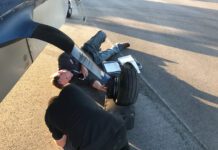I appreciated your article and will endeavor to be more conscious of dealing when pilots are in the right seat (“Right Seat Tips,” October 2010) in the future. Several years ago, in a rented 172, while on final for Runway 27 at Oshkosh, Wis., to attend EAAs AirVenture, and after controllers directed a turn to base sooner than I would have done, I let a presumed more-experienced pilot in the right seat 288 take the controls to demonstrate a slideslip. I will not do that again. I made that decision pretty quickly after the event, but your article has reinforced it. Thanks for the article. Mike White, Anybody-even a close-to-checkride student-probably has a story or two they can tell about someone in the other seat. Misunderstandings Your December 2010 article, “Got Rudder?” was really great. I read it twice and set it aside to read a third time. The author did a good job explaining the “why” of Wolfgang Lang-wiesches quote, “The rudder then is not of equal rank with the ailerons; it is the servant of the ailerons. You use rudder because you are using the ailerons.” The rudder induces roll, but roll is never its purpose: The purpose of the rudder is to control adverse yaw. Steven Gibb has cleared up some misunderstandings on my part. This is why I read your magazine. Thank you. William Abbott, Show And Tell 288 I am a retired airline pilot who started my commercial aviation tour as a bush pilot operating in Alaska. Twenty-two thousand hours later, I retired from the left seat of a Boeing 747. I subscribe to your excellent magazine. “Got Rudder?” is right on in many ways except many student or other low-time pilots wont quite understand your lesson. I think it can only be taught in the airplane where the CFI does a “show and tell” thing. A few years ago, I landed a stretched DC-8-63 full of passengers on the single runway at Lajes in the Azores. I made a gross error by starting my descent too early, which resulted in a forced landing at Lajes with the wind 90 degrees to the runway and gusting to over 80 knots. Rudder, aileron, elevator and throttles all played a part. This one approach and landing utilized every word of your article. As you may have guessed by now, my 258 passengers and I survived the experience. Thanks for the article. Larry Partridge, Pulling The Prop I am a long-time subscriber, but I dont fly so much anymore. Regardless, I still get a lot out of your magazine. The September 2010 issue had a good article, “From Denial to Final” It makes a good point, and I have it in my bag of tricks. My confusion is in the prop setting. I imagine the writer means full coarse pitch (full out), the opposite of the fine-pitch takeoff setting (full forward). This all-the-way-out thing is a little foreign to us older guys, when it was sacrilegious to pull the wrong one first, for fear pulling the prop control too far would ruin the engine. “From cruise to low-rpm” sounds a little like you go back the other way, whereas you continue to pull through cruise to low-rpm. Just a nit, but I found myself going over this a few times to get that I understood him. Aviation Safety is still the only one and the best. Thanks! Art North,
Kennewick, Wash.
Columbus, Neb.
La Conner, Wash.
Via e-mail



